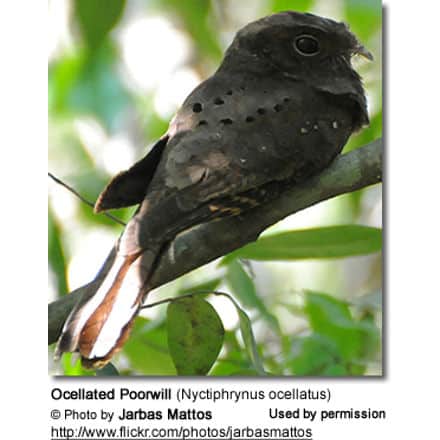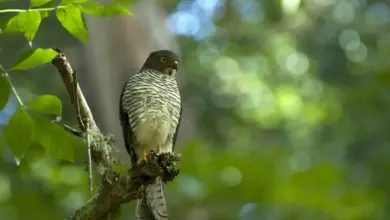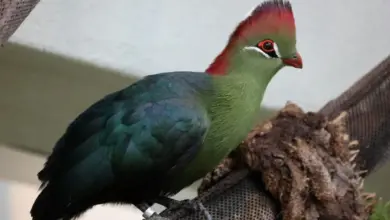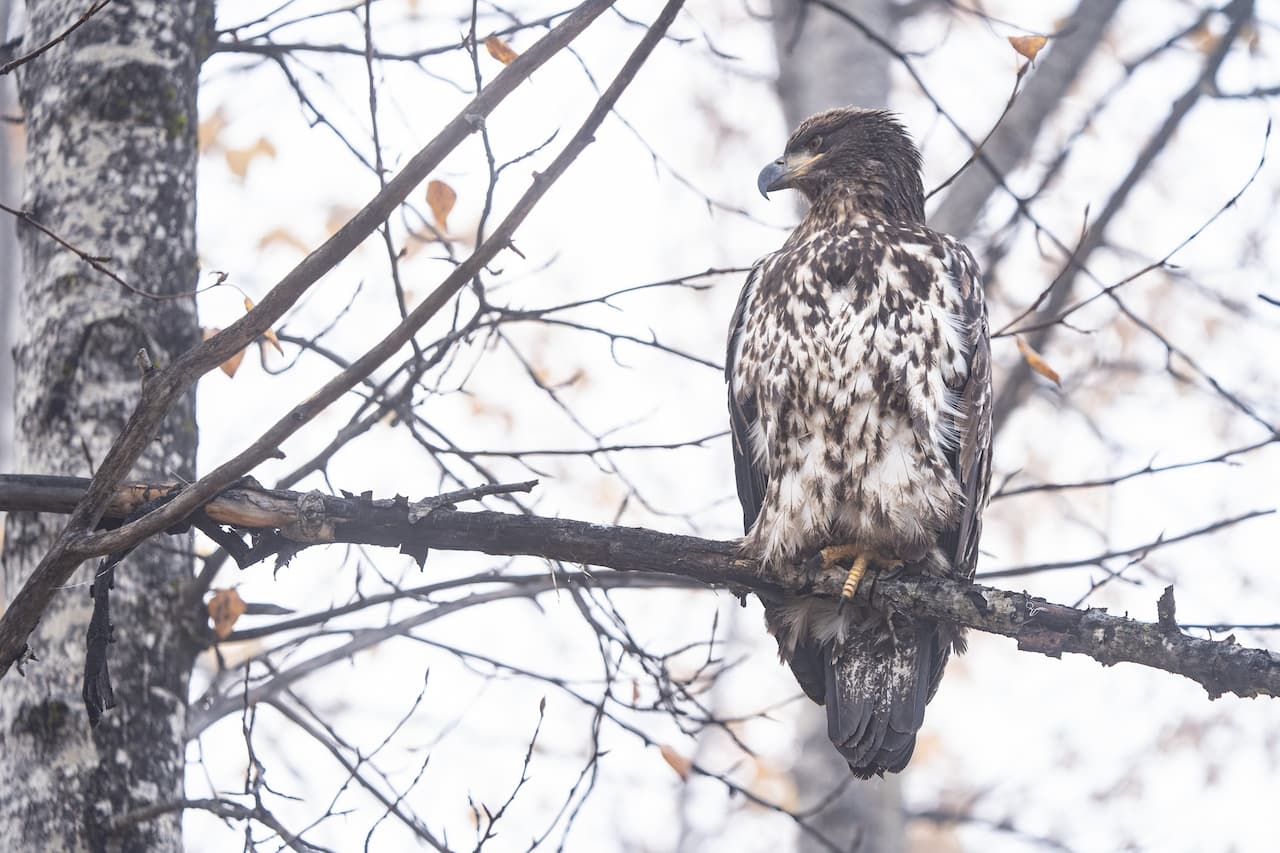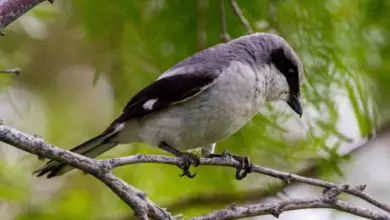Ocellated Poorwills (Nyctiphrynus ocellatus)
The Ocellated Poorwills (Nyctiphrynus ocellatus) occurs naturally in Central and South America.
The nightjar, as suggested by the name, is strictly nocturnal. Throughout the day, it typically rests quietly in densely vegetated hiding places. At night, they become active as they hunt flying insects in more open landscapes, such as forest clearings, wetlands, and along rivers.
Due to their cryptic appearance, they blend perfectly into their woodsy habitat, and they are very difficult to spot during the daytime when they are usually hidden away from sleeping.
These birds are most easily detected at night when light from car headlights is reflected red from their eyes, as they are sitting on tracks or roads.
However, their presence is most often made known by their loud calls given at dusk.
Alternate (Global) Names
Chinese: ??? … Czech: lelek o?katý … Danish: Perlepoorwill … Dutch: Gevlekte Poorwill … German: Augennachtschwalbe … Estonian: tõmmu-öösorr … Finnish: Täpläkehrääjä … French: Engoulevent ocellé … Guarani: Kereveve … Italian: Succiacapre ocellato … Japanese: komonyotaka … Norwegian: Plettnattravn … Polish: lelek oczkowany … Portuguese: Bacurao-ocelado, bacurau, Bacurau-ocelado, cariaponga, curiango … Russian: ????????? ??????? … Slovak: lelek ockatý … Spanish: Atajacaminos, Atajacaminos ocelado, Chotacabras Ocelado, Guardacaminos Ocelado, Pachacua Ocelada, Pocoyo Ocelado … Swedish: Fläcknattskärra
Distribution
The Ocellated Poorwills are found in Argentina, Bolivia, Brazil, Colombia, Costa Rica, Ecuador, Honduras, Nicaragua, Paraguay, and Peru.
They inhabit subtropical or tropical moist lowland forests and moist montanes.
Subspecies and Ranges
- Nyctiphrynus ocellatus ocellatus (Tschudi, 1844) – Nominate Race
- Range: Central southern Colombia, northeastern Ecuador, and eastern Peru to eastern Brazil and south through Bolivia and Paraguay to northeastern Argentina and extreme southern Brazil.
- Nyctiphrynus ocellatus lautus (W. deW. Miller and Griscom, 1925)
- Range: Northeastern Nicaragua, northwestern Costa Rica, extreme eastern Honduras, and possibly Panama (Canal Zone).
Description
Ocellated Poorwills are medium-sized nocturnal birds with long pointed wings and very short bills. They have short legs and small feet, of little use for walking. There is a distinctive wide bar on the throat.
Males have white-tipped tails. Their soft plumage is cryptically colored to resemble bark or leaves. They blend perfectly into their habitat, making them very difficult to spot during the daytime when they are usually hidden away from sleeping.
Their presence is most often made known by their loud calls given at dusk.
Juveniles lack the well-defined markings of the adults.
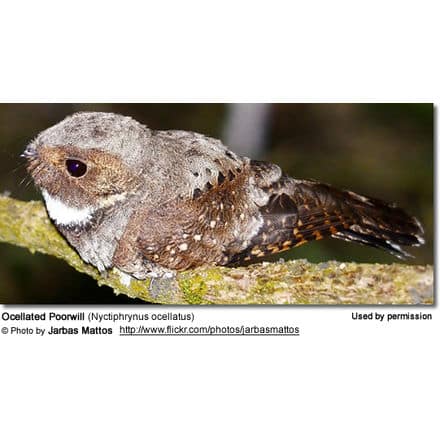
Calls / Vocalizations
The Ocellated Poorwills calls are described as an emphatic rising and falling trilled note that sound like “prEEoo“.
Nesting / Breeding
The male establishes his territory and sings at night to keep rivals away and at the same time to attract a female.
Nightjars don’t construct a nest, as most other bird species do. They simply place the eggs on the ground on open soil covered with dead leaves. They appear to have a propensity for nesting near trails or open corridors through the forest. (Ref.: David L. Anderson – The Peregrine Fund).
Nesting appears to be timed in such a way that the moon is more than half full at the time they are feeding their young – likely as the additional light during the night facilitates caring for the young and foraging for food.
The female may lay one to two eggs (mostly two) that are one egg that is pinkish-cinnamon in color with fine, chestnut spots on the larger, more rounded end. (Ref.: David L. Anderson – The Peregrine Fund).
During the day, the incubation of the eggs is undertaken by the female, while both parents share the incubation at night. The incubation period is about 19 to 21 days.
The hatchlings are covered in down and are capable of short-distance movements within 24 hours of hatching. They usually move apart shortly after hatching, maybe to make it more difficult for predators to spot them. The parents also shove them apart with their feet as they flush from the nest. The male usually stands guard and defends the nest and the young. He will hover in place near the nest with his body in a nearly vertical position. The adults communicate with their young via soft clucking sounds to which the chicks respond.
Both parents feed the young regurgitated food (insects), and they continue to brood them until they fledge. The young take their first flight when they are about 20 to 21 days old.
If conditions are favorable, the female may lay a second clutch close to the first and while she is incubating the new set of eggs, the male continues to care for the young from the first brood.
They have developed several behavioral adaptations to minimize predation:
- Their nocturnal (night) lifestyle reduces the likelihood of being detected by daytime predators. During the daytime, they typically sleep on the ground where they are perfectly camouflaged by their “earthy” colored plumage. They almost always change their roost sites daily.
- When nesting, they sit quietly on the eggs, minimizing any movements that could get them detected.
- If an intruder does get close to the nest, the parents may try to lead them away by first flushing off the nest and when landing feigning injury as they lead the potential thread away from the nest. While the parent performs this distraction display, the young may scatter and freeze.
- The parent who is not incubating the eggs or brooding the young will roost away from the nesting area.
- They may also move the eggs or young to prevent them from being preyed upon.
- Nightjars avoid voicing when they hear the calls made by predatory nocturnal animals, such as owls.

